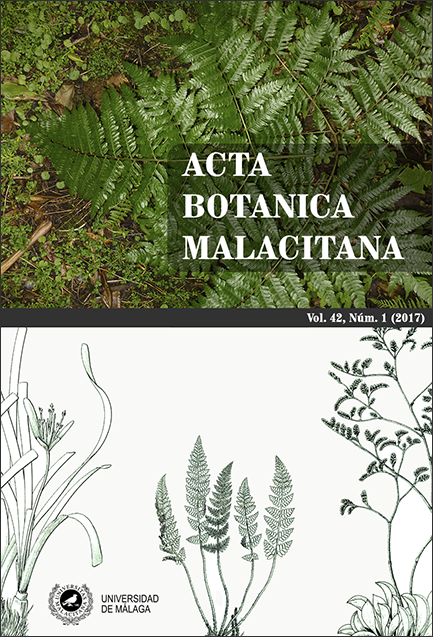Stomatal traits in Iberian populations of Osmunda regalis (Osmundaceae, Polypodiopsida) and its relationship with bioclimatic variables
DOI:
https://doi.org/10.24310/abm.v42i1.3029Resumen
Stomata are very conserved structures in plants, which allows and control the gas exchange. This ecophysiological fact appears to be critical in the ecology and adaptation of plants to environment. Plant individuals can, among other issues, adjust size and density of the stomata to adapt themselves to hydric, thermic and light regimes. In turn, this led to the reduction of transpiration and control of water losses, which is crucial in areas with Mediterranean climate. The fern Osmunda regalis has populations in both biogeographical regions of the Iberian Peninsula (Eurosiberian and Mediterranean regions), but when locations are highly continental the populations are scarce and isolated. The objective of this study is to characterize the stomatal morphological traits in both regions, to detect possible adaptations in individuals occurring in Mediterranean locations. 26 individuals of 17 different populations were sampled. Applying microscopic techniques, 4447 observations of length and width, and 234 of density and PCI were done. The sampling spots were characterized by two bioclimatic indices of Emberger and Gorzynski, and also mean maximum and minimum temperature values were obtained. All the information was included in a dataset that was statistically analyzed with the software SPSS. Our results show that Osmunda regalis fronds have higher PCI and density values in the Eurosiberian region, as expected. Gorczynski continentality index (K), and the mean maximum and minimum annual temperatures influences over stomatal traits. This is clearly informing that in the Mediterranean region, the temperature is an important factor that triggers stomatal adaptations of O. regalis to continental locations with higher levels of environmental stress. On the contrary, Emberger pluviometric index (Q) seems to be less explicative by its own. Perhaps this is related with the habitat of O. regalis in soils with high freatic level, fact which could lead to a more independent stomata from rainfall.Descargas
Métricas
Citas
Ackerly, D. D., et al. (2000). The evolution of plant ecophysiological traits: Recent advances and future directions. Bioscience 50: 979-995.
Boer, H. J., et al. (2016). Optimal allocation of leaf epidermal area for gas exchange. New Phytologist 210: 1219-1228.
Brodribb, T. J. & Holbrook, N. M. (2004). Stomatal protection against hydraulic failure: a comparison of coexisting ferns and angiosperms. New Phytologist 162: 663-670.
Brownlee, C. (2001). The long and the short of stomatal density signals. Trends in Plant Science 6: 441-442.
Chaves, M. M., et al. (2002). How plants cope with water stress in the field. Photosynthesis and growth. Annals of Botany 89: 907-916.
Cochard, H., et al. (2002). Unraveling the effects of plant hydraulics on stomatal closure during water stress in walnut. Plant Physiology 128: 282-290.
Cowan, I. R. (1977). Stomatal behaviour and environment. Advance in Botanical Research 4: 117-228.
Doi, M., et al. (2006). The fern Adiantum capillus-veneris lacks stomatal responses to blue light. Plant and Cell Physiology 47: 748-755.
Evert, R. F. & Eichhorn, S. E. (2006). Esau’s Plant Anatomy. New York, USA. Wiley.
Ferrer-Castan, D. & Vetaas, O. R. (2005). Pteridophyte richness, climate and topography in the Iberian Peninsula: comparing spatial and nonspatial models of richness patterns. Global Ecology and Biogeography 14: 155-165.
Franks, P. J. & Farquhar, G. D. (2007). The mechanical diversity of stomata and its significance in gas- exchange control. Plant Physiology 143: 78-87.
Gabriel y Galán, J. M., et al. (2011). Biometry of stomata in Blechnum species (Blechnaceae) with some taxonomic and ecological implications for the ferns. Revista De Biologia Tropical 59: 403-415.
Galmés, J., et al. (2007). Water relations and stomatal characteristics of Mediterranean plants with different growth forms and leaf habits: responses to water stress and recovery. Plant and Soil 290: 139-155.
Galmés, J., et al. (2007). Photosynthetic limitations in response to water stress and recovery in Mediterranean plants with different growth forms. New Phytologist 175: 81-93.
Galmés, J., et al. (2013). Leaf responses to drought stress in Mediterranean accessions of Solanum lycopersicum: anatomical adaptations in relation to gas exchange parameters. Plant, Cell & Environment 36: 920-935.
Haworth, M., et al. (2013). Co-ordination of physiological and morphological responses of stomata to elevated [CO2] in vascular plants. Oecologia 171: 71-82.
Henriot, A. & Cheype, J. L. (2012). Piximètre, la measure des dimensions sur images. In. Hetherington, A. M. & Woodward, F. I. (2003). The role of stomata in sensing and driving environmental change. Nature 424: 901-908.
Holland, N. & Richardson, A. D. (2009). Stomatal length correlates with elevation of growth in four temperate species. Journal of Sustainable Forestry 28: 63-73.
Hunt, M. A., et al. (2002). Ecophysiology of the soft tree fern, Dicksonia antarctica labill. Austral Ecology 27: 360-368.
Joffre, R., et al. (1999). Functional attributes in Mediterranean-type ecosystems. In: F. I. Pugnaire & F. Valladares (eds.), Handbook of Functional Plant Ecology: 347–380. New York.
Jones, H. G. (1998). Stomatal control of photosynthesis and transpiration. Journal of Experimental Botany 49: 387-398.
Kato, M. & Imaichi, R. (1992). Leaf anatomy of tropical fern rheophytes, with its evolutionary and ecological implications. Canadian Journal of Botany 70: 165-174.
Kawai, H., et al. (2003). Responses of ferns to red light are mediated by an unconventional photoreceptor. Nature 421: 287-290.
Kessler, M., et al. (2007). Patterns of morphological leaf traits among pteridophytes along humidity and temperature gradients in the Bolivian Andes. Functional Plant Biology 34: 963-971.
Kluge, J. & Kessler, M. (2007). Morphological charactersitics of fern assemblages along an elevational gradient, patterns and causes. Ecotropica 13: 27-43.
Mcadam, S. a. M. & Brodribb, T. J. (2012). Stomatal innovation and the rise of seed plants. Ecology Letters 15: 1-8.
Meidner, H. & Mansfield, T. (1968). Physiology of stomata. London, UK. McGraw-Hill.
Metcalfe, C. R. & Chalk, L. (1979). Anatomy of the Dicotyledons. London, UK. Clarendon.
Moreno, J. C. & Lobo, J. M. (2008). Iberian–Balearic fern regions and their explanatory variables. Plant Ecology 198: 149-167.
Moreno, J. C., et al. (2015). Atlas de los pteridófitos de la Península Ibérica e Islas Baleares. Acta Botanica Malacitana 40: 5-55.
Öpik, H. & Rolfe, S. A. (2005). The physiology of flowering plants. Cambridge, UK. Cambridge University Press.
Prabhakar, M. (2003). Structure, delimitation, nomenclature and classification of stomata. Acta Botanica Sinica 462: 242-252.
Reich, P. B., et al. (1999). Generality of leaf trait relationships: A test across six biomes. Ecology 80: 1955-1969.
Riano, K. & Briones, O. (2013). Leaf physiological response to light environment of three tree fern species in a Mexican cloud forest. Journal of Tropical Ecology 29: 217-228.
Rivas Martínez, S. (1987). Nociones sobre fitosolociología, biogeografía y bioclimatología. In: M. Peinado & S. Rivas Martínez (eds.), La vegetación de España: 19-45. Alcalá de Henares.
Rivas-Martinez, S. & Rivas-Saenz, S. (1996-2017). Worldwide Bioclimatic Classification System. http:// www.globalbioclimatics.org/. Phytosociological Research Center, Spain (accessed october 2016). In. Royer, D. L. (2001). Stomatal density and stomatal index as indicators of paleoatmospheric CO2 concentration. Review of Palaeobotany and Palynology 114: 1-28.
Salisbury, E. J. (1927). On the causes and ecological significance of stomatal frequency, with special reference to the woodland flora. Philosophical Transactions of the Royal Society B 216: 1-65.
Schulze, E. D., et al. (1973). Stomatal responses to changes in temperature at increasing water stress. Planta 110: 29-42.
SIGA (2016). Sistema de Información Geográfica de Datos Agrarios (http://sig.mapama.es/siga/). Ministerio de Agricultura, Pesca, Alimentación y Medio Ambiente. España (accessed oct 2016). In. Wagner?Cremer, F., et al. (2007). Influence of ontogeny and atmospheric CO2 on stomata parameters of Osmunda regalis. CFS Courier Forschungsinstitut Senckenberg 258: 183-189.
Xu, Z. & Zhou, G. (2008). Responses of leaf stomatal density to water status and its relationship with photosynthesis in a grass. Journal of Experimental Botany 59: 3317-3325.
Descargas
Publicado
Cómo citar
Número
Sección
Licencia
Toda la información relacionada con la licencia de uso de los trabajos publicados en Acta Botanica Malacitana y con los derechos de autor se pueden consultar en nuestra Política Editorial.







1.png)


